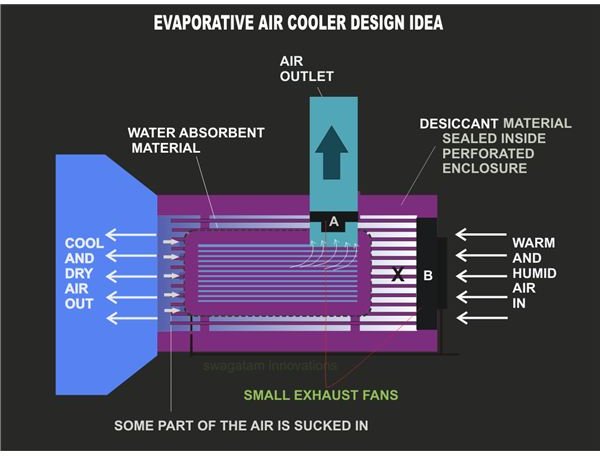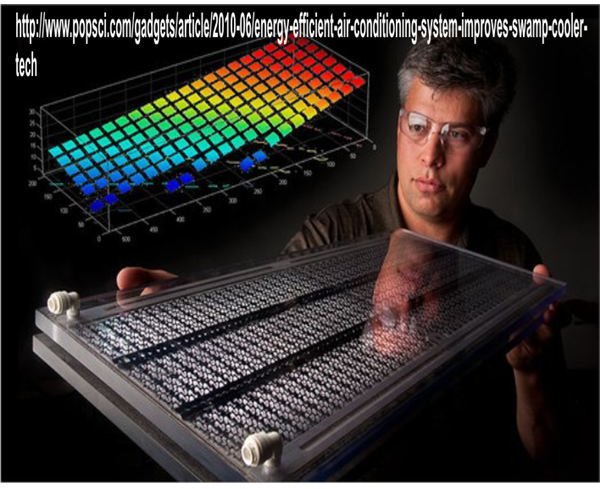Evaporative Cooler Technology to Replace Conventional Air Conditioning
Eco Friendly Concept
The last 100 years have perhaps witnessed the height of massacre that the human race can do to our only planet’s natural resources. We did it in every possible way- we cleaned up more than 50% of the rain forest, depleted the ozone layer, guzzled up fossil fuel to near-exhaustion, increased global warming- you name it. But, we have slowly but surely realized this and the future looks quite bright as scientists are trying hard to find nature friendly technological alternatives that may benefit mankind without affecting mother earth.
For example, if we look at the conventional room air conditioners (ACs), it appears, that the state-of-the-art cooling technology is at its best. But some intellectuals don’t think likewise. They feel that even the modern room air conditioners are not efficient enough and are responsible for eating up 5% of a nation’s produced electricity, giving out excess heat as a byproduct that’s adding up to the global warming. Moreover, the chemicals utilized as coolants are in no way ecofriendly. This has led the scientists to design methods of cooling air which may be more efficient, renewable and ecologically beneficial.
Inspired from nature itself, NREL (the National Renewable Energy Laboratory) has invented (or rather modified) an air conditioning device incorporating an innovative technology called “Desiccant-Enhanced eVaporative air conditioner – DEVap.” An evaporative cooler with this technology not only cools the air, but also dehumidifies it in a pretty efficient way.
Let’s look more closely at the technology and design.
What’s DEVap: In Depth Evaluation
The idea is basically an improvisation of the age-old technology still employed in conventional evaporative coolers, which are also known popularly as “swamp coolers.” Here dry atmospheric air is forced to pass through water-laden material like hay or felt. When water molecules come in contact with dry air, they evaporate into the air (fluid always tend to move from heavier to lighter medium). The process involves sudden molecular (water) upheaval and sucks out heat to complete the process. This utilization and depletion of heat in the molecule itself creates the desired cooling effect.
To be more precise, our body has been using this phenomenon for ages- when the climate around us is warm, we sweat, and water particles in the sweat evaporate, decreasing our body temperature.
The above concept of cooling (in swamp coolers) looks quite impressive as it is cheap, efficient, and ecofriendly, and also since the air output from them is full of water molecules, proves quite healthy in arid areas and atmospheres having less than 25% of average humidity.
But in countries where humidity is at its peak or even above 50%, swamp coolers become useless. High humidity means less evaporation and thus less cooling. This is the basic reason why we feel sick when the atmosphere around us is hot and humid, and though we sweat a lot, it doesn’t help in cooling.
This is where the DEVap technology wins the race against the rather primitive one used in the swamp coolers.
According to NREL’s senior mechanical engineer and co-inventor of the technology Eric Kozubal, the present idea uses less than 50% of energy compared to the conventional air conditioners. The system not only cools and dehumidifies the air but also cleans the carbon content normally present in the atmosphere, helping the environment to become healthier and pollution free.
DEVap involves dividing (through polymer membranes) and forcing air through two discrete streams. Water is allowed to pass through one air stream, making it wetter and cooler through evaporation. This cool air decreases the temperature of a membrane, which in turn cools the air on the other side of it. The second stream of air is first dried up by passing it through desiccants and then is blown across the above cooler side of the membrane. This results in a perfectly cool and dry air output.
The desiccant used here is a liquid solution of calcium chloride, which is about 44 percent salt by volume. It is enclosed in special membranes which contains micrometer sized holes suitable enough to allow the water molecule to pass through but obstruct the desiccant fluid from seeping out.
So far everything seems pretty easy, but a logical and an obvious question would be what happens when the desiccants reach their saturation point. Things may go horribly wrong as then instead of dehumidifying, the system would start increasing the relative humidity of the room by adding up the water content of the desiccant,s and the cooling process would also stop.
The problem is simply solved by introducing a small heater and a blower into the system. Before the desiccants can reach their saturation point, the electric heater and the blower is automatically switched ON. Air heated by the heater is blown through the desiccants, which lose their moisture content into the hot air. This moisture absorbed hot air is then forced through an outlet vent back into the atmosphere. The desiccants again become fresh and reusable. The process is called recativation.
Although extra and a substantial amount of electricity may be consumed in the process, it cannot be considered a negative aspect of the system, as the overall power consumption of it still remains well below 50% than that of conventional air conditioners.
Homebuilt Evaporative Cooler Design Idea

The proposed concept of two stage evaporative cooler is so “cool” and overwhelming that I couldn’t help but design my own version of the device. The idea may appear quite crude to some, but it should help you understand the concepts.
It may be better understood through the following points:
-
Referring to the diagram (click to enlarge) we see that the system has two chambers X and Y.
-
One exhaust fan B sucks in the atmospheric warm and humid air and blows it into the hollow chamber X.
-
The whole of the chamber contains a layered grid of desiccant material sealed inside a perforated tubes.
-
The humidity of the air passing through this chamber is immediately absorbed by the desiccant grid and the air becomes free of all moisture.
-
Initially, exhaust fan A is kept switched OFF and for some time the air received at the output is just a dry warm air.
-
But as the desiccants begin to saturate, its water content is gradually transferred to the second layer of desiccant present at the inner area of chamber Y. When it becomes sufficiently wet, a moisture sensor toggles fan A.
-
This fan starts sucking out air from chamber Y rapidly. Since the sucked air is totally dry, its passage creates instant cooling of the accumulated water over the water absorbent material derived from the desiccants. Also, because the chamber is made up of a thin layer of aluminum, gets cool immediately.
-
Therefore, now the air blown in by fan B is treated in two ways. First, it’s dried up by the desiccants in chamber X and then cooled by the cold outer aluminum surface of the chamber Y.
-
Since the air sucked through vents on one side of the inner chamber Y is completely dry, it enhances a perfect cooling of the whole system.
-
The moisture accumulated inside the desiccants is effectively thrown back into the atmosphere by fan A and thus it is never allowed to saturate beyond its functional limit.
-
This two stage evaporative cooler very effectively utilizes water from the atmosphere itself for the cooling purpose and no external application of water is required.
